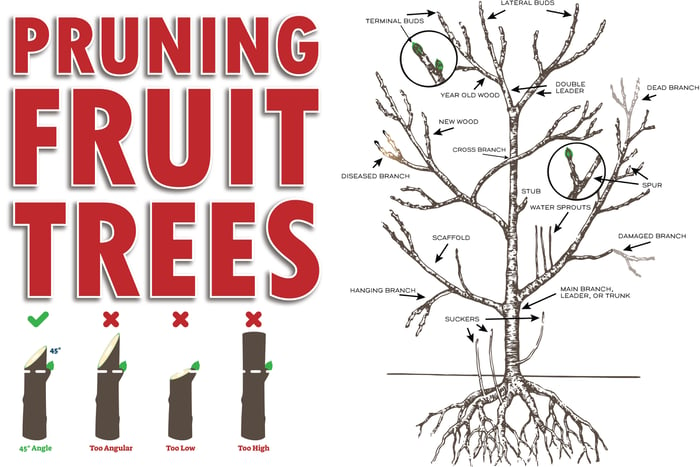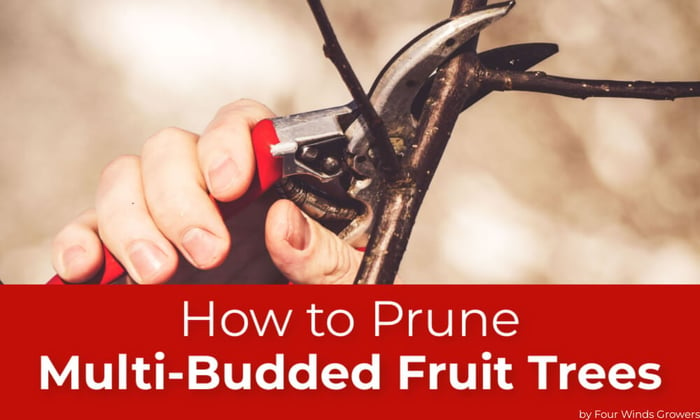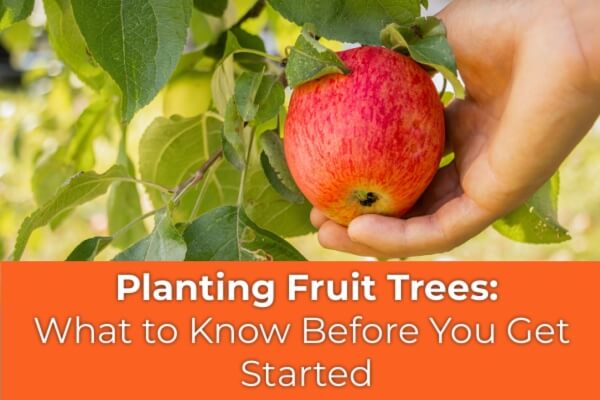Table of Contents
How to Plant and Grow Bare Root Fruit Trees
Planting and growing bare root fruit trees is a great way to jump ahead and get started with a more mature fruit tree. This is a relatively easy process but there are a few critical steps for success. Here is a step-by-step guide on how to receive, plant, and water your new bare-root fruit tree. Learn more on how to plant a bare root fruit tree here.
#1. Receiving Your Tree:
Immediately upon receiving a bare root tree, remove it from its box to make sure to inspect the roots and see that they are still moist. One way to keep roots damp is to give the roots a quick rinse and repack them in the packing material in which they arrived until you are ready to plant. Alternatively, the use moist autumn leaves, wood chips, or even shredded newspaper will keep the roots damp until you are ready to plant. Note that the roots should be fully covered and kept moist until you are ready to plant.
Keep your tree cool (ideally between 30° and 40°F) to prevent the tree from breaking its dormancy. After wrapping the roots in packing material and plastic to hold in moisture, put the plant in a cool place away from sun. Another way to hold a tree in good condition before planting is to heel it in. On the cooler side of your house, dig a shallow hole that is just deep enough for the roots and temporarily plant the tree there.
Just before planting time, inspect a tree’s roots, removing any that are dead, diseased, or broken. Cleanly cutting frayed ends reduces the surface area of wounds, so that healing is quicker and risk of root disease is reduced. Keep the roots from drying out when taking a tree to its planting site by keeping it wrapped in moist cloth or newspaper.
#2. Prepare the Planting Site
Before digging a planting hole, scoop up a handful of dirt and squeeze it. If it’s ready for digging, the soil will be just moist enough to crumble readily. If the soil is too wet, wait for it to become drier. Digging soil that is too wet, especially one that is high in clay, ruins its crumbly structure. If it’s too dry, water it.
Dig the hole a little deeper than the root is tall and make it wide enough to accommodate the longest roots without bending.
Make sure that the hole is tapered from ground level at the edges to full depth at the center, like a wide, shallow cone. For easy root penetration, rough up the inside of the hole by poking it with a shovel and giving it a few twists.
If lime or sulfur is needed to change the pH of the soil, thoroughly mix it into the bottom of the planting hole. Both of these materials move slowly through the soil and take a long time to work their way down to the roots.
Do not mix fertilizer into the planting hole, since it could burn new roots. Also, do not add peat moss, compost, or other organic materials.
#3. Planting and Watering
Shovel enough loose soil back into the planting hole to create a mound on which to set the tree. The top of the root ball should stand slightly higher in the soil, to allow for settling.
Backfill with native or slightly amended soil until the bottom of the hole is at the right planting depth for the tree. If multi-planting in one hole, backfill to correct planting depth for each tree.
Prune off any broken, rotted, or twisted roots, making clean cuts.
Place your tree in the planting hole and backfill with native or slightly amended soil. Be sure that the graft is sitting at least a few inches above the final soil level.
Water your new tree. Slowly and thoroughly soak the ground and allow the water to seep in. Do this two times.
Once planted, water once per month until the tree breaks dormancy and begins to leaf out.
Once the tree breaks dormancy and throughout its first growing season, diligently maintain a weekly watering schedule. One gallon per week per-square-foot spread of the roots.
#4. Post-Planting Tree Care
Prune the canopy of your tree at this time. If you want the fruiting wood to begin low, smaller trees may be cut back at planting time to a height as low as the knee (15-20 inches). Any remaining side limbs should be cut back to one or two buds. Larger trees may be cut above existing well-placed low limbs, or they too may be cut back low to force new, lower limbs. If this step is skipped, you will likely see low vigor from the first season, dieback from these long branches, or even complete failure to break dormancy.
Protect the trunk of your tree from sunburn, pests, and insects with IV Organics Plant Guard tree paint and foliar spray. Paint your newly planted tree from the ground up. This step is particularly important for our growers in the southwest where the climate where the intense sun tends to damage trees.
Spread 3" of wood chips or straw over the bare ground to within a few inches of the trunk. Keep mulch away from the trunk to prevent the trunk from rotting. This insulating blanket will keep the roots of the trees warm and growing and also prevent freezing and thawing of the soil. It will also keep the roots of the trees cool and moist through summer.
Stake trees that stand over 3' tall or in very windy areas for at least a year until their roots grab a firm hold of the soil. Tie the trunk to one or two stakes set beside the tree, using some soft material or padded wire. Allow for some movement of the trunk.
Keep your circle of mulch weed-free for at least a few years, adding more mulch as needed.
With proper planting and care, new buds will soon push out and your tree will start its journey!
If your tree does not break dormancy by May, you will want to check for signs of life on your tree. One of the best ways to determine if a tree or any plant is dead is the scratch test. Scratch off the top layer in a small spot on a branch or on the trunk. Just beneath the dry, outer layer of bark in a tree's trunk lies the cambium layer of bark. In a living tree, this is green; in a dead tree, it is brown and dry.
If the tree is green and still living, stop watering for the next 14 days. Bare root trees have no leaves and no way to expel excess water.
If your tree is dead or does not push after 14 days, contact your grower for more guidance.
Source: Davewilson.com




